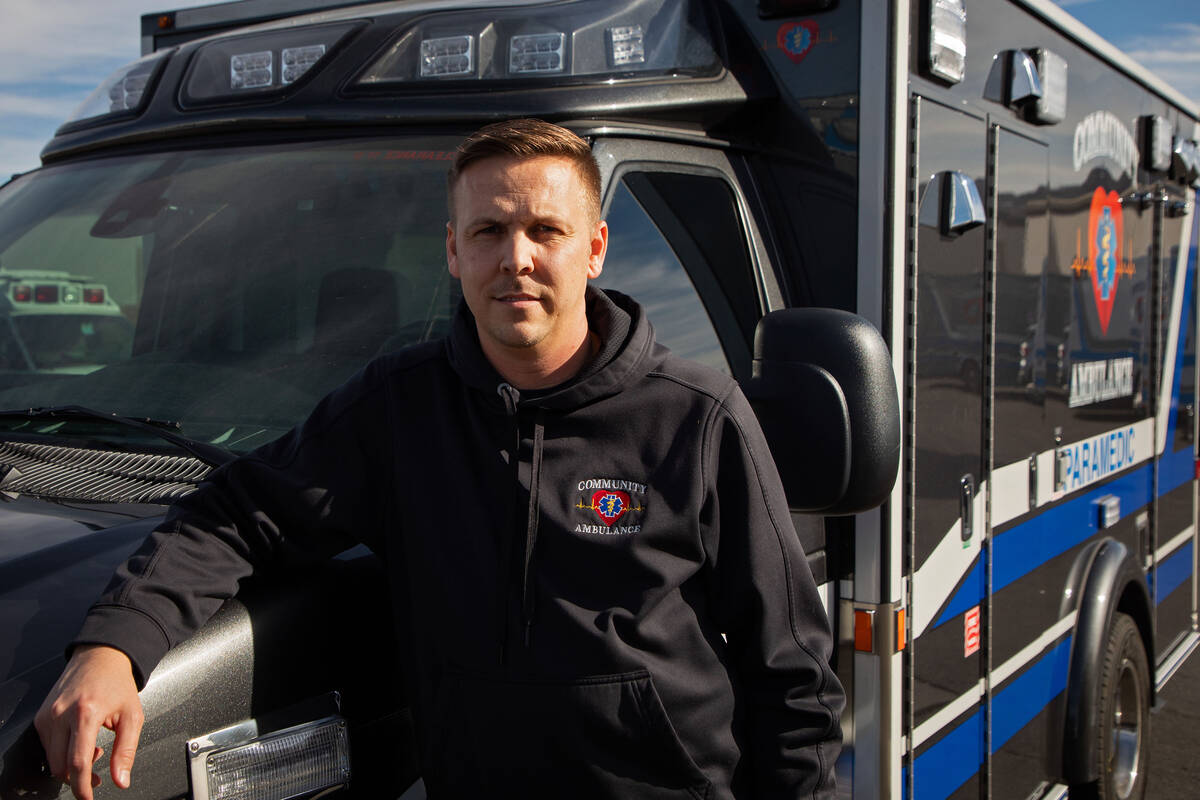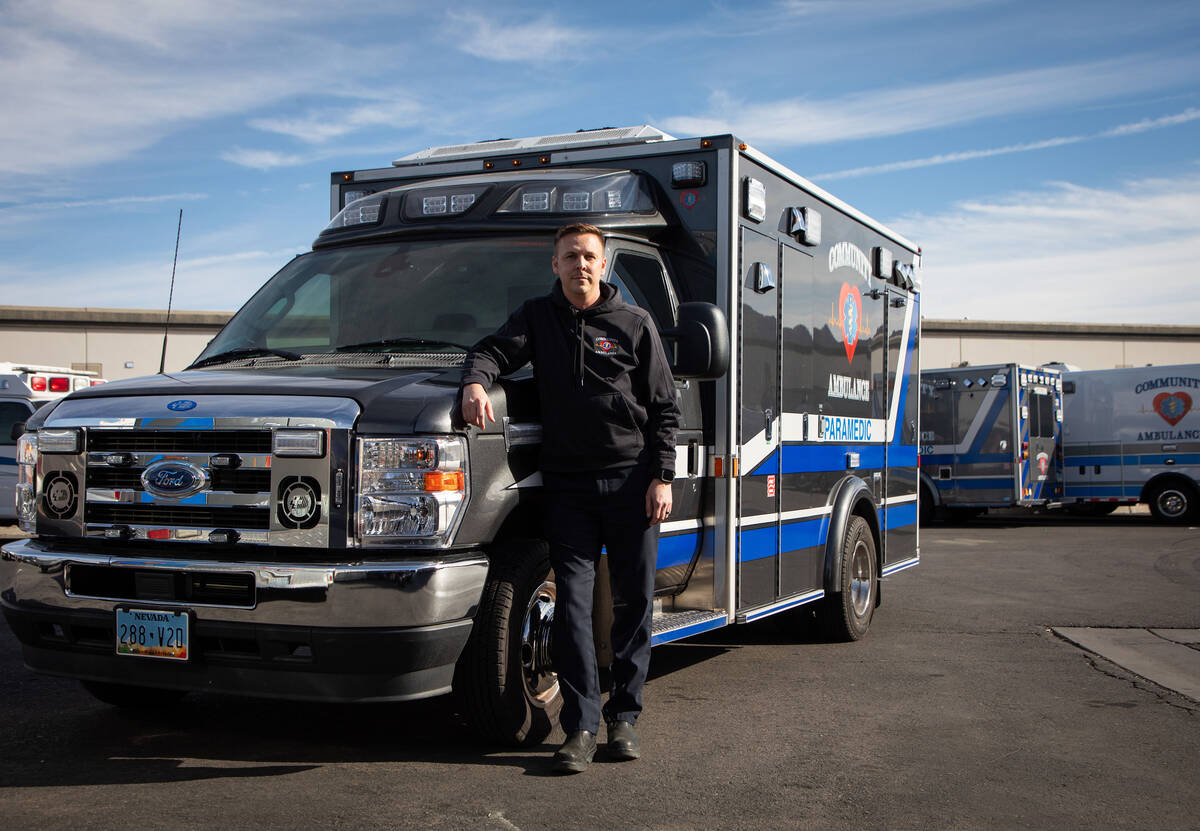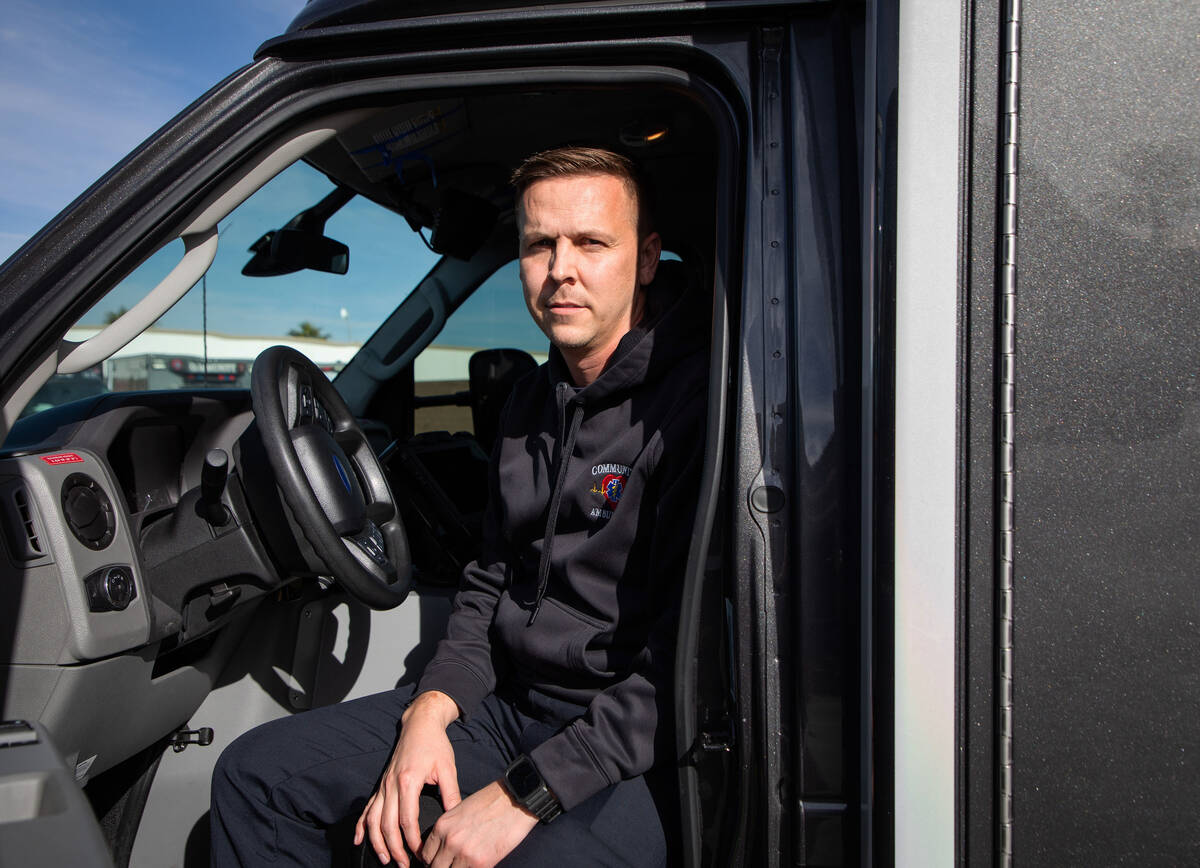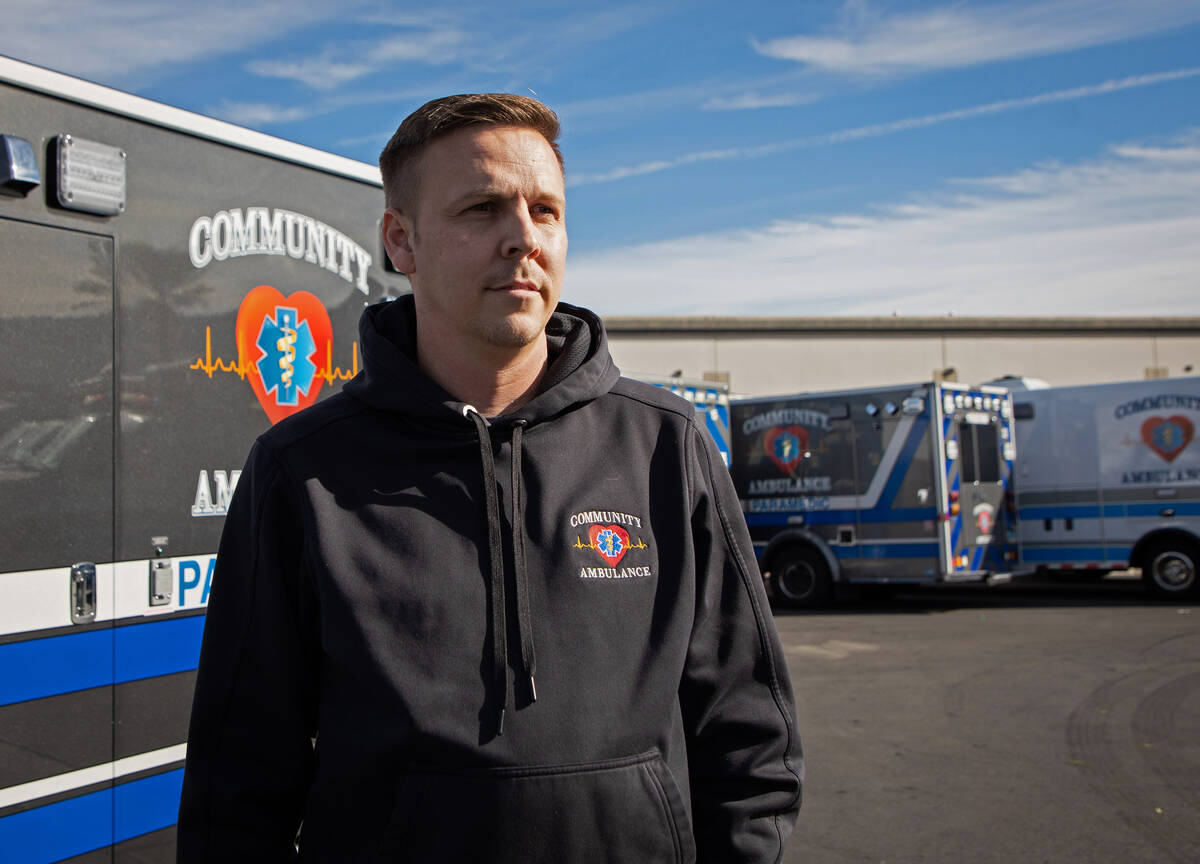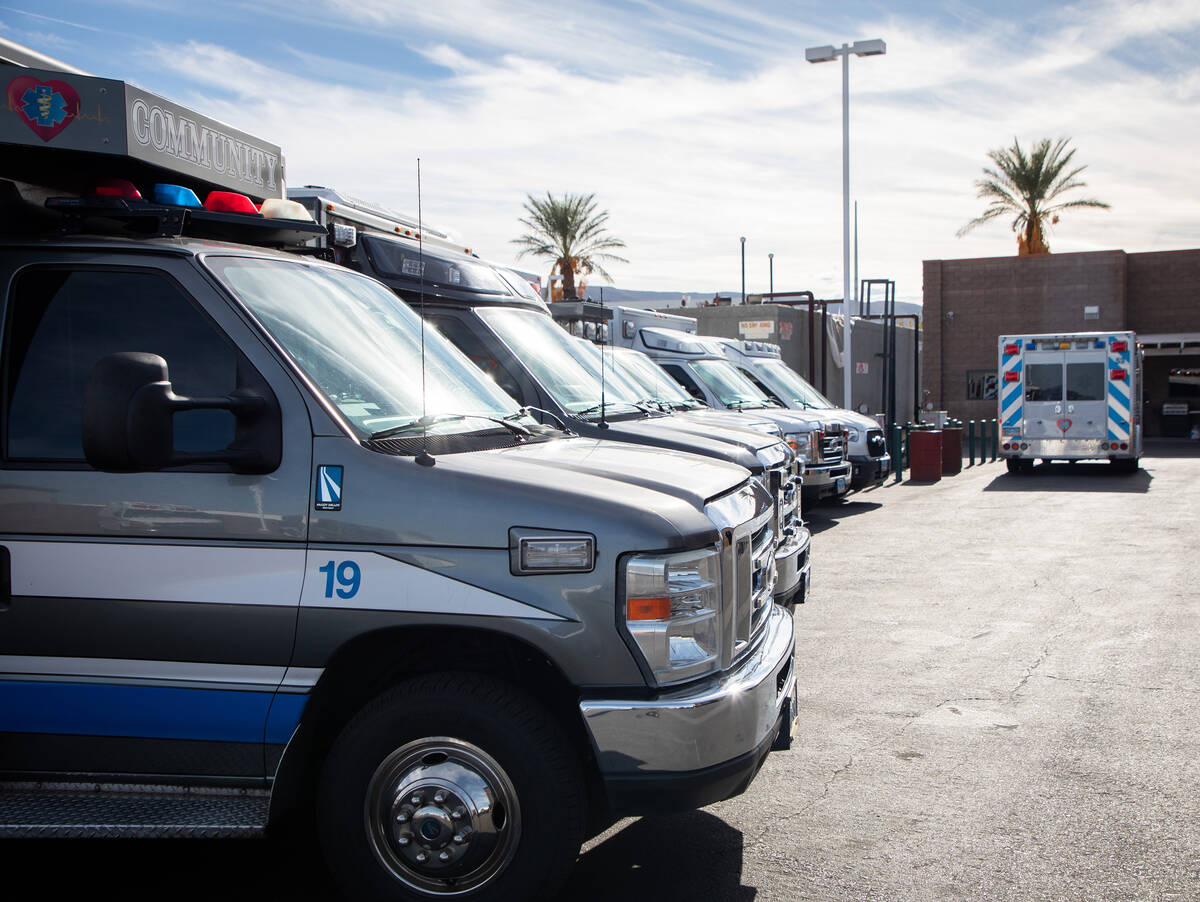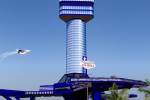‘This is an emergency’: Ambulance maps changed due to slow response times
The Clark County Fire Department responds to every 911 medical emergency in its jurisdiction.
If it looks like a person will require hospitalization, a private ambulance is also dispatched to the scene.
The ambulance crews have 12 minutes to arrive before being considered late. It’s then, most often, that the fire department takes over their duties, stretching already-thin public resources, according to county officials.
Per contractual obligations with Clark County that run until 2026, the ambulance companies are out of compliance if they’re late to more than 10 percent of their calls each month.
In a recent 17-month period, the two largest ambulance companies in Southern Nevada — AMR and MedicWest, both owned by Colorado-based Global Medical Response — only reached the 90 percent on-time benchmark one and zero times, respectively, fire department Deputy Chief Jen Wyatt told county commissioners in a Nov. 15 presentation.
AMR averaged 85.2 and 85.6 percent in its two zones, while MedicWest had rates of 76.0 and 83.3 percent in its respective areas, according to Wyatt.
This has amounted to nearly $2 million in penalties since November 2021, figures obtained by the Review-Journal show.
“This is an emergency,” Commissioner Michael Naft said during the meeting. “There is no contract we have more significant than this one.”
Naft was part of a unanimous vote that then approved a fire department plan to redraw ambulance zones handled by the three companies with county contracts.
A third company, Community Ambulance, hadn’t fallen out of compliance a single time since February, when it gained more turf from the other companies under a November 2021 redistricting, Wyatt said.
AMR and MedicWest also have contracts with the city of Las Vegas, and the latter is the sole operator in North Las Vegas. Community Ambulance provides nonemergency services to the city of Henderson. The municipalities did not provide requested performance data by publication time.
Redistricting
The new Clark County map, which takes effect Jan. 3, increases the local company’s footprint on the Strip, gaining a new zone that averages nearly 31,000 annual calls.
In total, Community Ambulance will be tasked with 52 percent of total calls in Clark County, an increase from about 17 percent before the 2021 redistricting.
AMR and MedicWest — which until February handled roughly 83 percent of all calls — say redistricting alone isn’t the solution for a staffing crunch in the ambulance industry as a whole.
But Community Ambulance is ready for the increased workload, the company’s senior director, Glen Simpson, told the Review-Journal.
“Every time we’ve taken on a large lift, a large project, we’ve heard it, that we can’t do it, mostly from our competitors,” Simpson said. “I go back to our track record; it speaks for itself.”
Industry overhaul
An upcoming Clark County Fire Department academy of 110 cadets, half of whom come from the ambulance companies, will only strain an already dire situation, Michael Johnson later told the Review-Journal.
Thirty of the applicants are paramedics at AMR and MedicWest. Southern Nevada does not have enough institutions that produce paramedics, he added.
He said the county presented a map to AMR and MedicWest only a week before the November public hearing, and that most of the companies’ recommendations weren’t implemented. Johnson further said that the final map was only presented to him hours before the vote.
“It seems like the process is a little flawed,” Johnson said.
He said officials didn’t consider other factors before redistricting, such as how the change will affect already-established travel routes, distances, construction, infrastructure, flow and other performance points that are thoroughly examined with analytics. There are also already-dwindling revenue streams from “payer mixes,” or the claims filed with Medicare and insurance companies.
“All of those things should be factored into redistricting,” he said. “They are not the experts in my business; we are the experts.”
Wyatt said that the upcoming fire department academy “is not news to them,” that the agency had shared the names of the applicants, and that the career shift is historically a natural transition. She further said that they also knew redistricting was always an option.
Johnson only had about three minutes to try to persuade lawmakers to delay the decision during a public comment portion of the November meeting.
“I think that there’s an opportunity here. If we’re going to change the system, let’s change it to the system that’s going to work for all the stakeholders, including the community,” he told commissioners.
While they were unconvinced, commissioners said the discussion is not over. They asked for regular updates.
If there’s no improvement, Commission Chairman Jim Gibson said, “then we need to take a hard look at something more dramatic.”
Commissioner Marilyn Kirkpatrick told Wyatt she also was “irritated” with the final map, which she noted was different than one that had been presented to her.
According to Kirkpatrick, the plan doesn’t address underperforming ambulance responses in east Las Vegas.
“I don’t care how you slice or dice this, but if I don’t see any improvement, I’m bringing it back myself to have a different kind of conversation,” Kirkpatrick said. “Because someone has to service those people, and that’s your job.”
‘Fantastic, exciting career’
While a recruitment event was taking place during a recent morning at one of two AMR and MedicWest’s valley locations, a half-dozen employees sat in the dimly lit dispatch center evaluating several screens displaying real-time maps and analytics. Classrooms were occupied by future and current paramedics learning the trade.
According to the American Ambulance Association and the National Association of Emergency Medical Technicians, the EMS system has been deteriorating for more than a decade.
The pandemic, the current financial crisis, overwork and work-related trauma can exacerbate the problem. Community Ambulance paramedics, for example, were stationed at the Route 91 Harvest festival in October 2017 when a gunman opened fire during the deadliest mass shooting in American history.
To slow attrition, the company has prioritized mental health, said Simpson, the company’s senior executive. “What can we do to ensure that our employees’ well-being and mental health (are) at the forefront,” he said.
Changes are inspired by surveys where employees share “the good, the bad, the ugly,” he added.
After the county began to reopen after the initial pandemic-related closures, changes included decreased work hours and increased pay, benefit and signing bonuses.
While paramedics used to rotate between three- to four-day weeks, they are now on three-day weeks at 36 full-time hours, Simpson said.
On top of that, wages increased 15 percent and the company also added more paid time off.
The company is in the process of hiring more paramedics and procuring more equipment to be able to handle the 30,000 or so more calls a year.
Their employees, he said, are their best recruiters.
AMR and MedicWest have gotten creative in recruiting people who never before considered careers in the industry, Johnson said. They also implemented a “earn while you learn” program where employees are allowed to study to become paramedics while being employed.
In the last year, more than 100 employees graduated from basic medical courses, Johnson said. “It creates capacity for that next level of advanced EMT.”
The company invests more than $15,000 and 16 months to produce each paramedic, he said.
It’s a “fantastic, exciting career,” and the companies “provide pathways” to other industries, such as information technology, communications, management and flight paramedics, he added.
He said AMR and MedicWest are not opposed to their paramedics going into careers with the fire department but suggested self-regulation.
“How many people can you take at one given time,” he said. Maybe the fire department can host smaller classes to give the private ambulances time to recover, he added.
“When you take 20 (paramedics) from me, that’s close to a year’s worth of work,” Johnson said.
Having adequate staffing of paramedics would resolve the response times, Johnson said.
“If I had (enough) bodies, I would be able to put them on the street,” he said. “Even-steven.”
Contact Ricardo Torres-Cortez at rtorres@reviewjournal.com. Follow him on Twitter @rickytwrites.



